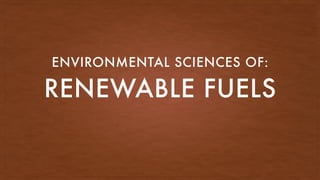
Env Science - Lesson 6
- 2. QUIZ TIME • What is deforestation? • Name one animal that humans have saved from extinction. • How did Einstein help save animals?
- 3. WHAT TYPES OF FUELS DO WE USE NOW? • What are fossil fuels? • Oil, Coal, and Natural Gas • link
- 4. WHY ARE FOSSILS FUELS NOT AS GOOD AS SOME OTHER TYPES OF FUEL? • Well, we already talked about fossil fuels emitting CO2 into the atmosphere. • This causes and increase in green house gases • Another reason is that fossil fuels are Non-Renewable Resources • This means that we use them faster than they can be made. • Eventually they will get used up.
- 5. WHAT ARE SOME OTHER ENERGY RESOURCES • Can anyone name a few? • Hydroelectric • Solar • Wind • Nuclear • Biofuels
- 6. SOLAR ENERGY • The sun’s energy is expressed in different ways, depending on what materials it interacts with. • Solar panels are built with materials that physically interact with certain wavelengths of solar energy. • This enables them to transform solar energy into electricity. Here’s how solar panels absorb and store energy
- 7. SOLAR PANELS • Solar panels are made with silicon crystals. • Silicon is a very special material. It creates an electrical current with sunlight. • When sunlight hits your skin, the electrons in the atoms of your body vibrate quickly to generate heat. This is a sunburn • But electrons do something different in silicon. The electrons start moving around. This means that the sun’s energy is conducted into an electrical current, rather than heat.
- 8. SO WHY AREN’T SOLAR PANELS EVERYWHERE, LIKE EVERYWHERE • What if it is cloudy? • Solar panels are not super efficient yet. • That means that the usable energy is a lot from solar panels.
- 9. HOW MANY RENEWABLE RESOURCES ARE USED • Many of the energy sources use a turbine generator • In a turbine generator, a moving fluid— such as water, steam, gases, or air— pushes a conductor in a circle. • Just outside the conductor is a huge magnet • Remember moving magnets by a conductor move electrons. • The reverse is also true, a moving conductor by magnets moves electrons. Keep this in mind for the future slides
- 10. HOW DOES IT WORK HYDROELECTRICITY • This is a form of energy that harnesses the power of water in motion—such as water flowing over a waterfall—to generate electricity. • People have used this force for millennia. • Over two thousand years ago, people in Greece used flowing water to turn the wheel of their mill to ground wheat into flour.
- 13. HYDROELECTRIC POWER Think about the water as an infinite battery!
- 14. WIND IS LIKE WATER • Wind power or wind energy is the use of wind to provide the power through wind turbines to turn electric generators, which will make electricity for use! • This is exactly how the hydroelectricity works!
- 15. NUCLEAR ENERGY (FISSION) • Nuclear energy originates from the splitting of uranium atoms – a process called fission. • This generates heat to produce steam, which is used by a turbine generator to generate electricity. • Because nuclear power plants do not burn fuel, they do not produce greenhouse gas emissions.
- 16. NUCLEAR ENERGY (FISSION) • About 20% of America’s electricity comes from nuclear energy. • Nuclear energy accounts for 56% of our nation's carbon-free electricity. • Nuclear plants are the lowest-cost provider of large-scale electricity. • Some states generate more than half of their electricity from nuclear power.
- 17. NUCLEAR ENERGY WASTE • Even though, nuclear energy does not contribute to green house gases, it still produces waste. • Radioactive waste at that! • This radioactive was can stick around for hundreds of years! • And no spidey powers!
- 18. NUCLEAR POWER (FUSION) • The Sun uses Nuclear Fusion which mixes two atoms together by throwing them at each other at really really really high speeds. • What if we could use nuclear fusion? • Well, that’s where Tokamaks come into the story.
- 19. TOKAMAKS • Tokamaks are in the shape of a huge doughnut. • They spin atoms so fast around the doughnut, they smash into each other and create energy! • The atoms are confined in the doughnut because the doughnut is one big ole magnet. • Our tokamaks get hotter than the sun!!!! • However, we are still working on this stuff and making it more efficient!
- 20. TOKAMAK
- 21. TOKAMAK
- 22. WHAT DO YOU GUYS THINK IS THE BEST ENERGY SOURCE?
- 23. HOW CAN PHYSICS HELP • Physics is essential in every use of our renewable and nonrenewable resources. • When someone asks What is physics? Answer: The study of energy of every form. • Every physics class will talk about: 1. What is the concept? 2. What is the math to prove the concept? 3. How does it relate to energy? • Remember, Energy is the ability to do work or push something (You can push a box or a battery can push electrons.)
- 24. LETS REVIEW • How does a turbine work? • Hydroelectricity? • Wind? • Solar? • Nuclear (fission)? • Nuclear (fusion)?